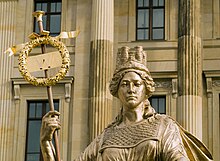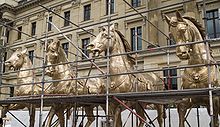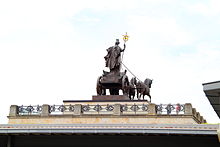Brunswick Quadriga


The Braunschweiger Quadriga , first made between 1855 and 1863, is a larger than life group of sculptures. It consists of Brunonia , the allegorical patron saint of Duke Wilhelm , the Duchy and the city of Braunschweig , who, standing in an antique, two-wheeled chariot , steers a team of four horses (the quadriga ), holding the reins with her left hand and the right holds a staff of honor, at the top of which is a laurel-wreathed "W" for Duke Wilhelm. The third team of four based on the preserved original model has been standing on the replica of the Braunschweig residential palace since October 23, 2008 .
Five squares in Germany
In Germany there are five quadrangles, of which the Braunschweiger is by far the largest: The group, cast from silicon bronze between 2006 and 2008, weighs 25.8 tons and is 9.50 meters at its highest point. Brunonia alone is 5.30 meters tall, the four draft horses each 4.30 meters. The four other teams are the Berlin Quadriga on the Brandenburg Gate , the Munich Lion Quadriga on the Siegestor , the Dresden "Panther Quadriga " at the Semperoper and the "Panther Quadriga" at the Alte Oper in Frankfurt am Main . There is also a 1: 3 variant of the Braunschweiger Quadriga, which was located on the " Züchner Villa " in Seesen am Harz from 1923 to March 24, 2018 , and was then dismantled. It was made between 1890 and 1893 for the 1893 World's Fair in Chicago .
The Berlin Quadriga dates from 1793. This group of figures with the goddess of victory Viktoria, about five meters high, was designed by Johann Gottfried Schadow . The Munich Quadriga on the Siegestor, which was built around 1852, shows Bavaria with four Bavarian lions as draft animals. It comes from Friedrich Brugger , Johann Martin von Wagner and Johann von Halbig. The Dresden “Panther Quadriga” on the Semperoper was modeled by Johannes Schilling from 1871 to 1877; it depicts Bacchus and Ariadne with the panthers mentioned above.
History of origin
The first Brunswick residential palace was a half-timbered building on which no quadriga stood. The builder was Hermann Korb , who started construction in 1717. The construction work dragged on in several stages until 1791. On September 7, 1830, the castle burned down to the ground during the Braunschweig Revolution . The revolution forced a change on the Braunschweig throne, and shortly afterwards court architect Carl Theodor Ottmer was commissioned to build a new residential palace, which was completed on March 21, 1841.
Ottmer had planned a quadriga for the central wing of the palace for the palace, which is unique in Germany and Europe. As with the Berlin Quadriga and the former Roman Quadriga, festival architecture underpinned the team: a triumphal gate , a temple front and a high attic with a pedestal and lateral triumphal columns. The subject matter was a patron saint of the duchy and the city of Braunschweig with a deity of light and a muse or Victoria, based on the victorious outcome of the wars against Napoleon , in which Wilhelm's father and grandfather had lost their lives. Duke Wilhelm's reign for a peace and reconstruction policy was to find graphic support in the quadriga. This project came to a standstill in 1839 at the latest, when Wilhelm forbade further construction of the palace grounds for reasons of economy. This eliminated the colonnades, the entire architectural ornamentation on the west side and - for the time being - also the quadriga.
1863: the first quadriga

In 1855 the state assembly, the duchy's estates, commissioned the construction of a quadriga. It was supposed to be a present for Duke Wilhelm on the occasion of the 25th anniversary of the throne on April 25, 1855.
The 1: 3 model for this first quadriga was designed by the Dresden sculptor Ernst Rietschel (1804–1861) between 1855 and 1860. It is still preserved today in the Dresden Albertinum . Based on this model, the Braunschweig sculptor and ore caster Georg Ferdinand Howaldt and his sons drove the Quadriga out of individual copper plates between 1857 and 1863 in their own workshop (the later “ Okerburg ” on Hochstrasse) and then mounted it on a metal frame. Originally the delegation of the state assembly had planned a bronze casting of the quadriga, which would have become too heavy for the central wing of the castle and too expensive for the country.
However, the project was delayed because of Rietschel's initially negative behavior and because of the simultaneous work on other still images. Rietschel died in 1861 and did not live to see the installation. After completing the very elaborate work, the Quadriga was placed on the central building of the palace in autumn 1863, and on November 21st it was donated to Duke Wilhelm as part of a “ducal table” in the palace. Georg Ferdinand Howaldt was appointed professor for "Modeling and Bossing" at the Collegium Carolinum because of his outstanding performance . In the spring of 1863, a stepped platform made of iron girders was specially built for the quadriga in the middle wing of the palace, on which the group was firmly riveted.
Just two years later, on the night of February 24, 1865, the Quadriga was destroyed in a major fire due to an accident in the north-western part of the castle, which also affected the central wing, when the platform collapsed and the entire group of figures fell several floors down causing the quadriga to melt from the heat. Only a few metal sheets and Brunonia's head as the largest piece could be saved. The head has been on view in the Braunschweig Municipal Museum since 1868 . When casting the third Brunonia (2008), it was initially planned to use the original head that had been preserved, but this was not possible for material reasons.
1868: the second quadriga
From May 1866 to October 1868, Howaldt created a second version of the Quadriga - also driven from individual copper plates and then mounted on a metal frame, which was made around 1.5 m smaller than the first Quadriga and a height of 9.8 m had. Optical defects in the first Quadriga caused the commissioned state assembly to reduce the scale. The second quadriga stood from November 1868 until the end of the Second World War , whereby - unlike the city and the castle itself - it remained almost undamaged by the bombing. Even the devastating bomb attack of October 15, 1944 only meant that the platform on which it was standing sank a little, but the group of figures was still intact. Only after the end of the war was the Braunschweiger Quadriga almost completely dismantled and thus destroyed by non-ferrous metal thieves over the course of several years . The metal “skeleton” of the Quadriga was not salvaged when the castle was demolished, but rather scrapped. In May 2004 the figure's left index finger was rediscovered by chance in the Braunschweigisches Landesmuseum . It makes the dimensions of the entire work clear: It weighs 754 grams, is 29 centimeters long and has a diameter of 10.5 centimeters at the thickest point.
2008: the third Quadriga
In 2004, 59 years after the end of the war and 44 years after the Ottmer building was demolished, the City Council of Braunschweig decided to have the Braunschweig Castle rebuilt in connection with a shopping center, the so-called "Castle Arcades", at the original castle location . At first it was not intended to have a new Quadriga manufactured. The reason for this was the expected costs: At first, around two million euros were expected.
Then, however, the Richard Borek Foundation decided to fund a third version of the Quadriga. In contrast to their predecessors, the new four-team was cast from bronze in Emil Kosicki's foundry in Komorniki near Posen , as the original manufacturing process of making copper would have been too complex, time-consuming and therefore too expensive.
The original plan was to set up the third Quadriga including Brunonia on May 6, 2007 on the occasion of the official and ceremonial opening of the castle on the central building. Up to this date, however, it had only been possible to lift the four draft horses with wooden structures supported on the central building. The chariot was not yet cast and only existed as a model. The Brunonia was already in Braunschweig on May 6, but it was damaged when it was being charged in Poland and could not be erected because it was not yet completed. It was therefore to be viewed as a lying figure. At the opening, only the four horses stood on the central projection , which were taken down and stored the next day.
In the meantime, it also became clear that the Braunschweiger Quadriga, due to its size, was a "building subject to approval" according to Lower Saxony's building regulations , for whose static safety, for example, more stringent requirements apply to wind loads at a height of 26 m. So the group of figures had to be reinforced by adding a stainless steel skeleton. This work took place from summer 2007 to April 2008, then the group was put together on a trial basis so that the last missing parts could be added. The inauguration of the Quadriga took place on October 27, 2008 after it had been installed the week before.
Design, dimensions and weight
The third version of the Quadriga was made based on the original 1: 3 model of the first Rietschel Quadriga, which is now in Dresden's Albertinum . As in 1863, it is the largest quadriga in Germany. Initially the group of figures shone golden, but gradually turned brown. In a few years, the weather will eventually give it a green patina .
The Braunschweiger Quadriga is approximately 9.20 meters high, 7.50 meters wide and 9.50 meters long. The Brunonia has a size of 5.30 meters. Her head was designed from a cast of the original head from 1863. The chariot on which she stands is 4.60 meters long, 2.30 meters high and 2.60 meters wide. Its two wheels are 2.90 meters high. The four horses measure 4.60 meters at the highest point and are 4.70 meters long. The entire group of sculptures, including the stainless steel skeleton built in later to absorb the wind loads, weighs around 25.8 tons.
The production costs of 700,000 euros were taken over by the Richard Borek Foundation, which gave the Quadriga to the city of Braunschweig as a gift in 2008. The city of Braunschweig bears the follow-up costs for technical checks, cleaning and necessary renovations.
A staircase, illustrated with pictures of the history of the Quadriga and the Residenzschloss, provides information about the origins of the three Braunschweig Quadriga and silhouette sketches on the four platform balustrades about the viewpoints in the Braunschweig cityscape.
literature
- Helmut Trunz: Quadriga. Splendid highlight of the Braunschweig Castle. Braunschweig 2009.
- Bernd Wedemeyer: The former residential palace in Braunschweig. Documentation about the building and its demolition in 1960. 2nd edition. Braunschweig 1993.
- Bernd Wedemeyer: Quadriga - The four-horse carriage of the residential palace in Braunschweig. Appelhans Verlag, Braunschweig 2011, ISBN 978-3-941737-65-5 .
- Bernd Wedemeyer, Eva-Maria Willemsen: Braunschweiger Hofkultur 1830-1918. Equipment and fragments of the former residential palace. Braunschweig 2001, ISBN 3-87091-002-X .
Web links
- Original model of the Braunschweiger Quadriga ( Memento from January 1, 2006 in the Internet Archive )
- Quadriga website of the city of Braunschweig
Individual evidence
- ↑ Bernd Wedemeyer: Quadriga - The four-horse carriage of the residential palace in Braunschweig. Appelhans Verlag, Braunschweig 2011, ISBN 978-3-941737-65-5 , p. 57 ( appelhans-verlag.de ).
- ↑ Bernd Wedemeyer: The former residential palace in Braunschweig. A documentation about the building and its demolition in 1960. 2nd edition, Braunschweig 1993, p. 96
- ↑ Bernd Wedemeyer: The former residential palace in Braunschweig. A documentation about the building and its demolition in 1960. 2nd edition, Braunschweig 1993, p. 151
- ↑ New Quadriga costs two million euros. In: Braunschweiger Zeitung. October 23, 2003 (fee required).
- ↑ Final spurt in Poland: Quadriga should go to the castle this year. In: Braunschweiger Zeitung. September 4, 2007 (fee required).
- ↑ Data on the 3rd Braunschweig Quadriga. ( Memento from February 7, 2009 in the Internet Archive )
- ↑ Donation Agreement . (PDF).
- ↑ Quadriga as a visitor magnet. on der-loewe.info.
Coordinates: 52 ° 15 ′ 48 ″ N , 10 ° 31 ′ 39 ″ E




